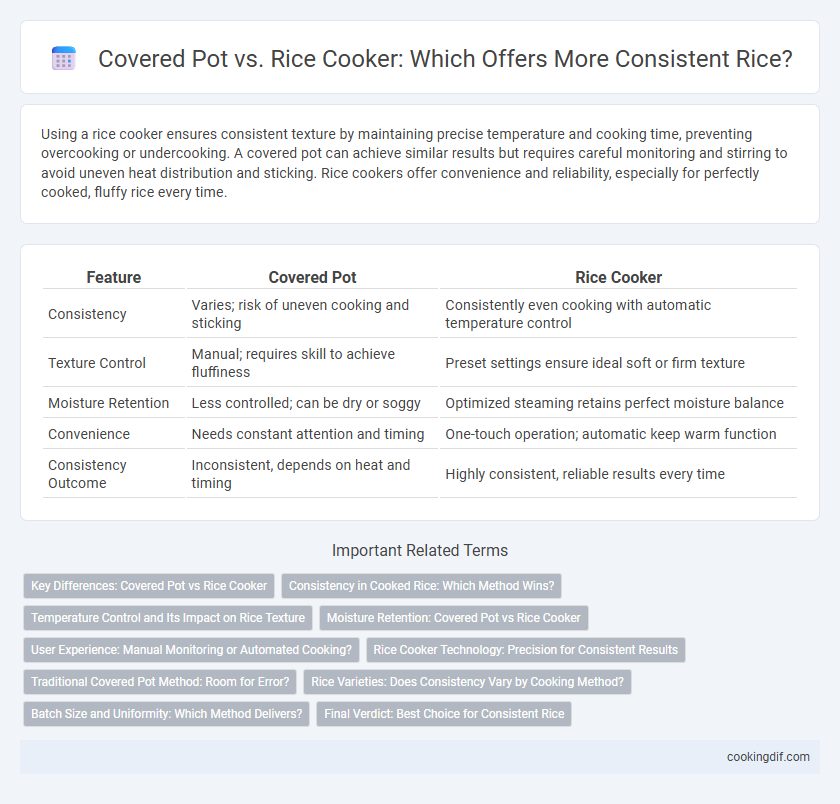Using a rice cooker ensures consistent texture by maintaining precise temperature and cooking time, preventing overcooking or undercooking. A covered pot can achieve similar results but requires careful monitoring and stirring to avoid uneven heat distribution and sticking. Rice cookers offer convenience and reliability, especially for perfectly cooked, fluffy rice every time.
Table of Comparison
| Feature | Covered Pot | Rice Cooker |
|---|---|---|
| Consistency | Varies; risk of uneven cooking and sticking | Consistently even cooking with automatic temperature control |
| Texture Control | Manual; requires skill to achieve fluffiness | Preset settings ensure ideal soft or firm texture |
| Moisture Retention | Less controlled; can be dry or soggy | Optimized steaming retains perfect moisture balance |
| Convenience | Needs constant attention and timing | One-touch operation; automatic keep warm function |
| Consistency Outcome | Inconsistent, depends on heat and timing | Highly consistent, reliable results every time |
Key Differences: Covered Pot vs Rice Cooker
A covered pot relies on manual heat control and observation, often resulting in variable rice moisture and texture due to uneven heat distribution. Rice cookers use automated temperature sensors and timers, ensuring consistent cooking by maintaining optimal steam levels and preventing overcooking. The key difference lies in the rice cooker's precision technology, which delivers uniform consistency compared to the traditional covered pot method.
Consistency in Cooked Rice: Which Method Wins?
Rice cookers provide more consistent results compared to covered pots by maintaining precise temperature and moisture levels throughout the cooking process. Covered pots often require manual adjustments and constant monitoring, increasing the risk of uneven cooking or burnt rice. Consistency in cooked rice is best achieved with rice cookers due to their specialized heating systems and automated controls.
Temperature Control and Its Impact on Rice Texture
A rice cooker maintains precise temperature control through built-in sensors, ensuring consistent heat distribution that produces evenly cooked, fluffy rice with optimal texture. A covered pot relies on manual stovetop heat settings, which can lead to uneven temperature and inconsistent rice texture due to potential hotspots or overheating. Accurate temperature regulation in rice cooking directly impacts starch gelatinization and moisture absorption, critical factors for achieving perfect rice consistency.
Moisture Retention: Covered Pot vs Rice Cooker
A covered pot retains moisture by trapping steam, which helps maintain the rice's natural texture and prevents excessive drying. Rice cookers use automated temperature and moisture sensors to optimize consistency, ensuring even cooking and ideal moisture levels. Moisture retention in a covered pot depends on heat control and timing, while rice cookers provide precise adjustments for consistent results.
User Experience: Manual Monitoring or Automated Cooking?
A covered pot requires manual monitoring to maintain water levels and prevent overcooking, demanding user attention for consistent rice texture. Rice cookers feature automated sensors and preset cooking programs that adjust heat and timing for uniform results with minimal user intervention. Automated cooking in rice cookers enhances consistency and convenience, reducing the risk of undercooked or burnt rice compared to traditional covered pot methods.
Rice Cooker Technology: Precision for Consistent Results
Rice cookers utilize advanced temperature sensors and microcomputer technology to regulate heat and moisture levels precisely, ensuring consistently perfect rice texture and doneness. Covered pots rely heavily on stovetop heat control and manual timing, which can lead to uneven cooking and varying results. The precision of rice cooker technology minimizes user error, delivering fluffy, evenly cooked rice every time.
Traditional Covered Pot Method: Room for Error?
The traditional covered pot method for cooking rice often results in variable consistency due to uneven heat distribution and difficulty in precisely controlling moisture levels. Unlike rice cookers, which use automated temperature sensors and timers to ensure consistent cooking results, covered pots rely heavily on the cook's experience and stove heat management. This manual approach increases the room for error, frequently leading to undercooked or overcooked rice when not carefully monitored.
Rice Varieties: Does Consistency Vary by Cooking Method?
Rice varieties such as jasmine, basmati, and short-grain rice exhibit different texture profiles when cooked in covered pots versus rice cookers. Covered pots often allow greater control over moisture levels, resulting in firmer, less sticky grains for long-grain varieties, while rice cookers provide uniform heat distribution that enhances the fluffiness of short-grain and medium-grain rice. Consistency in cooking outcomes varies due to the heat retention and steam circulation differences inherent to each method, influencing the final texture based on the specific rice type.
Batch Size and Uniformity: Which Method Delivers?
Batch size significantly impacts rice consistency, with rice cookers offering better uniformity, especially in larger quantities. Covered pots require careful water-to-rice ratio adjustments and manual heat control, often leading to uneven cooking for bigger batches. Rice cookers utilize precise temperature regulation and sensor technology, ensuring consistent texture and uniformity regardless of the batch size.
Final Verdict: Best Choice for Consistent Rice
Rice cookers consistently deliver perfectly cooked rice by maintaining precise temperature and moisture control, ensuring even heat distribution throughout the cooking process. Covered pots can produce good results but often require more attention and skill to avoid uneven cooking or burning. For consistently fluffy and reliable rice every time, rice cookers are the best choice.
Covered pot vs rice cooker for consistency Infographic

 cookingdif.com
cookingdif.com